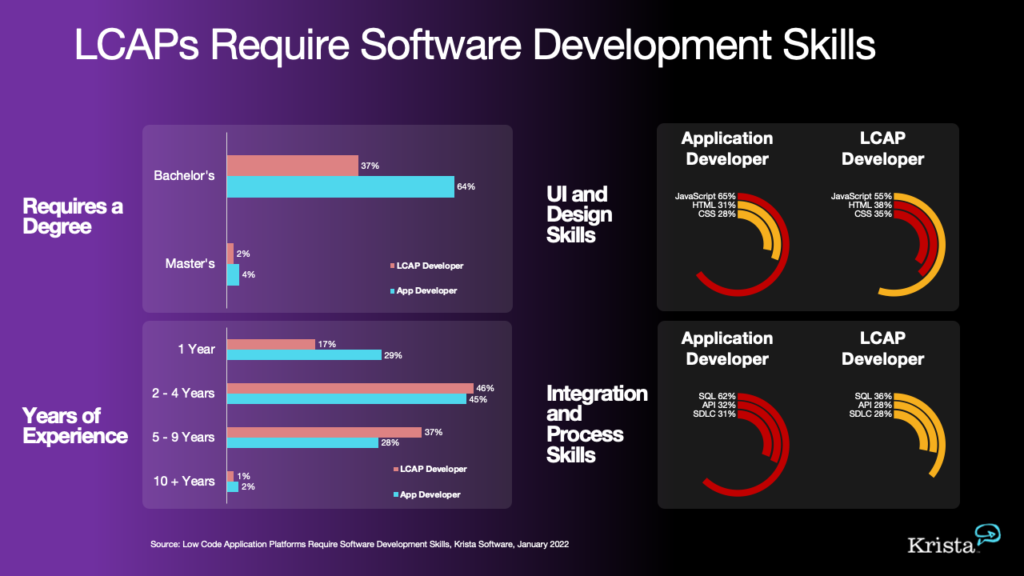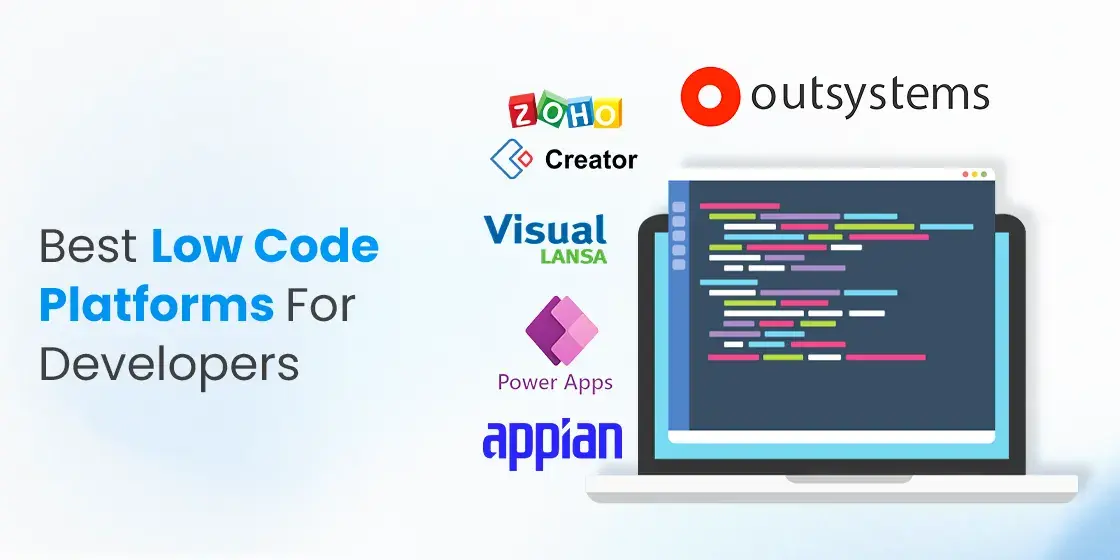New Facts To Choosing Low-code platforms for application development
Advantages Of Low-Code Application Development In Terms Of SpeedVisual Development Environment:
Drag-and-Drop Interfaces: Low-code platforms provide visual tools for designing applications. Developers can make use of drag-and-drop elements to build applications quickly without writing extensive code.
Pre-built Templates and Components: A lot of low-code platforms have templates and components that are pre-built, that allow developers to quickly develop and test applications without having to start from starting from scratch.
Reduced Coding requirements:
Automated Generated Code: Lowcode platforms generate the code base on the visual models developed by developers. This helps reduce the need to code manually and improves the speed of development.
Reusable components: Developers can to utilize reusable components across a variety of projects, which reduces the amount of time they spend writing and testing code.
Collaboration can be made easier.
Integrated Development Tools: Low codes platforms usually have tools to test, version control and deployment. They help facilitate collaboration between teams.
Citizen Development: Business users as well as non-developers can help with the development of applications using simple interfaces, reducing the bottleneck of development often caused by the lack of availability of professionals.
Rapid Iteration and Prototyping:
Rapid prototyping. Developers can create prototypes in a short time to validate their ideas and receive feedback. This can lead to a faster iteration cycle.
Simple Modifications. Visual development makes it easy for users to modify and update their software.
Pre-built Integrations:
API Integrations. A number of low-code platforms offer connectors that are designed to work with popular APIs and services. This could reduce the time to integrate systems.
Data Integration: The tools integrated in the software make it easier and speed up the process of connecting databases, data sources, and applications.
Deployment and Scaling
Many low-code platforms provide an option to deploy applications in one click which can reduce the time and effort needed to set up applications.
Cloud-based Solutions: Cloud platforms with low-code enable developers to focus on the logic and functionality of their applications instead of worrying about the logistics of deployment.
Overall, the advantage of developing low-code applications in terms of speed lies in the ability of it to automatize and simplify many elements of the process, which allows for faster delivery of applications and quicker adaptation to changing requirements. See the top learn more on Low-code Platform for application development for blog recommendations including application modernization, application modernization software, application modernization, cross platform mobile app development, application modernization, jdbc server, azure sql, no code platforms, develop web application, developing mobile apps and more.

Low-Code Software Is Cost-Effective.
Low-code application development offers numerous benefits in terms of cost-efficiency and efficiency, which makes it an appealing choice for companies looking to maximize their development budgets while delivering high-quality applications. The main advantages:
Less Coding Needed: Low-code platform reduces the need for lengthy manual coding. This reduces time and effort of developers in developing their applications. This means less labor costs.
Lower Developer Resources: As low-code is more efficient and less time to develop, fewer specialized developers will be needed. This will drastically lower the cost of hiring and staffing.
More Time to Market
Accelerated cycle of development: Visual development tools as well as pre-built components provided by platforms that use low-code allow rapid application design, allowing companies to deliver products to market faster. This can result faster revenues, as well as improved position in the marketplace.
Rapid prototyping allows businesses to develop prototypes and test them in a short period of time, which can reduce the time required for the development phase. This lets them make quicker iterations after receiving user feedback.
Low Maintenance Costs
Simple Maintenance: Software developed on low-code platforms tend to be easier to maintain due to their standard components and modular architecture. This means that they are less likely to require ongoing maintenance and support costs.
Automated Updates. Many low-code platforms manage updates and patches automatically. Applications are secure and safe without needing extensive manual input.
Efficient Resource Utilization:
Contributions from non-developers Low-code platforms permit non-developers as well as business users to take part in the process of developing. This decentralization of the development process enables businesses to utilize the skills and talents of a wider variety of employees.
IT departments can focus on Strategic Initiatives: Instead, of being caught up in routine tasks of development, IT departments can focus their energies on strategic initiatives that increase productivity and efficiency.
Price models that can be scaled:
Subscription Pricing: A lot of platforms with low-code support flexible pricing models based on subscriptions that are scaled in accordance with the amount of usage. This allows businesses to alter their budgets in line with their requirements and needs without the need to incur large initial expenses.
Pay-Assosiated Options: Some platforms offer pay-assosiated alternatives. They ensure that businesses pay only for the resources they use and are beneficial for startups and small business that have limited resources.
Lower costs for third-party software:
Low-code platforms typically come with functions that are integrated, eliminating the need to purchase extra software or tools. This can help you save money on subscriptions and software licensing fees.
Pre-Built Intergrations: The ability to use pre-built integrations and pre-built integrations with popular systems and services reduces the need for custom development, and helps save time and money.
Improved ROI
Increased ROI: Businesses will achieve a higher ROI on their applications by combining rapid development, lower costs and a faster time to market.
Enhanced Ability. Businesses can quickly adapt the demands of customers and market trends and ensure that they remain relevant. They can also take advantage of new business opportunities when they occur.
Lower Cost of Training
User-Friendly Interfaces: Low code platforms offer intuitive and easy-to-use interfaces, which decreases the learning curve.
Accessible Resources: Many platforms that make use of low-code have extensive educational materials, tutorials as well as community support. This means that there is less requirement for formal education as well as the costs associated with it.
Collaboration streamlined:
Improved Collaboration Tools : The collaboration tools built-in to the software help in communication and coordination among team members. This leads to more efficient project development process as well as lower costs.
Unified Development Environment: A single unifying development environment can help improve workflows and reduces cost and complexity of managing multiple platforms and tools.
In the end, the value of developing low-code applications stems in its ability to lower development and maintenance costs, accelerate the time to market, improve utilization of resources, as well as provide flexibility in pricing. These factors provide substantial economic benefits to companies. Low-code development is an excellent option for companies that wish to increase budgets while still being able to create robust, scalable and quality software. Check out the top rated Legacy application modernization with Low-code info for more advice including cross platform mobile app development, stored sql procedures, no code platforms, azure sql server, cross platform app development, rad development, push alerts, app platforms, application modernisation, multiplatform mobile app development and more.

Benefits Of Low-Code App Development In Terms Of Limitations And Customization
Low-code app development is a well-balanced solution that provides significant benefits in addressing limitations while allowing customization. Here are the key benefits:Handling limitations:
: .
Low-code platforms facilitate development by providing pre-built templates and other components. This allows for faster deployment and the development of more complex applications.
Guided Workflows: A lot of platforms offer guided workflows and wizards that help developers navigate through complicated processes, reducing the chance of making mistakes and making sure that the process is consistent.
Scalability Solutions:
Scalability is built in: Low-code platforms typically include features that enable the development of scalable architecture. Applications are able to handle higher demands with little development.
Performance Monitoring: The tools that monitor and optimize performance can help ensure that the applications are effective even as they expand.
Security and Compliance
Integrated Security Features: Low-code systems come with built-in security measures including encryption, access control based on role, and automated compliance checks to address security issues that are common.
Regular updates: Platforms regularly update their security protocol and compliance procedures. This ensures applications remain secure from new threats.
Customization:
Extensibility:
Custom Code Integration : Low-code platform often allows the integration of customized code (e.g. JavaScript, Python), which allows developers to enhance the capabilities beyond the standard offerings.
Custom Modules and plugins: Developers have the option of creating custom modules or plugins in order to tailor specific functions to meet the specific requirements of a particular business.
APIs Integration
API Support: Comprehensive support for APIs allows seamless integration with other systems and services, which allows for extensive customization and connectivity.
Third-Party Services: Low-code platforms usually have pre-built connectors to well-known third-party services, making it simpler to connect and modify applications.
Flexible UX/UI:
Customizable User Interfaces: Developers may alter and design user interfaces that are in line with the specifications for branding and usability, creating a tailored user's experience.
Responsive Designs: The software can be tailored to fit various screen sizes and devices.
Business Logic Customization
Visual Workflow Builders - Visual tools to design and customize workflows, business logic and processes allow developers to design complicated and customized processes without lengthy programming.
Conditional Logic & Scripting : Platforms support conditional logic as well as customized scripting to deal with specific business rules.
Data Management:
Custom Data Modelling: Those who develop the models define custom models to fit particular requirements of the application. They can customize processing of data according to a company's specifications.
Advanced Data Processor: The integration of advanced data-processing tools and capabilities allows the customization of how data is processed and used within the application.
Balancing limitations with customisation:
Frameworks and Standards
Best Practices for Compliance: Low-code platforms encourage adhering to industry best practices and standards. This assists in maintaining high-quality scalable, and secure applications.
Governance Frameworks Governance Frameworks: Integrated governance frameworks ensure that any modifications don't interfere with the integrity, conformity or the security of an application.
Iterative Development and Feedback
Rapid Prototyping. Developers can iterate and modify applications based on feedback from users.
Low-code platforms facilitate continuous improvement, allowing for the continuous improvement of their design and enhancements the platform as requirements of business evolve.
User Empowerment
The empowerment of citizens-developers through low-code platforms increase the number of contributors capable of enhancing and modifying applications through permitting them to create custom intuitive user interfaces.
Support and Training Resources: Many platforms provide an extensive set of training and support resources to help users customize applications without jeopardizing their functionality or stability.
Overall, low-code application development gives a strong framework for addressing limitations while providing ample opportunities to personalize. This allows businesses to create and maintain applications that are efficient, adapted to their particular requirements and meet the highest standards of security, quality, and scaling.
